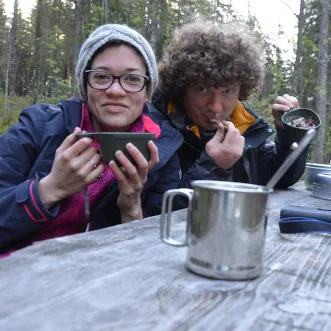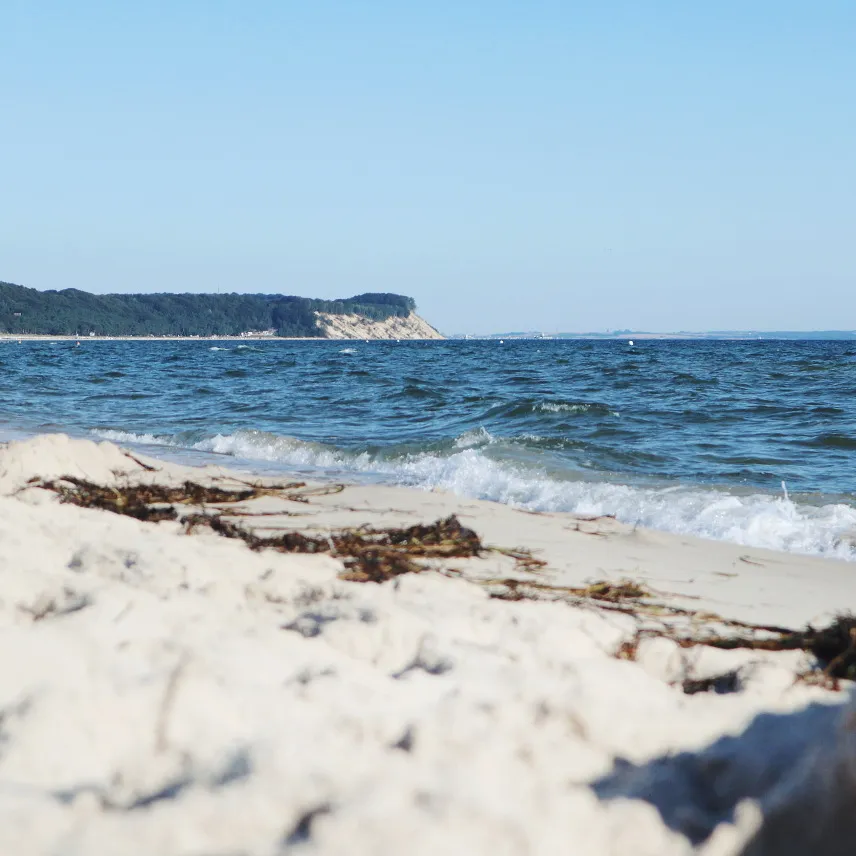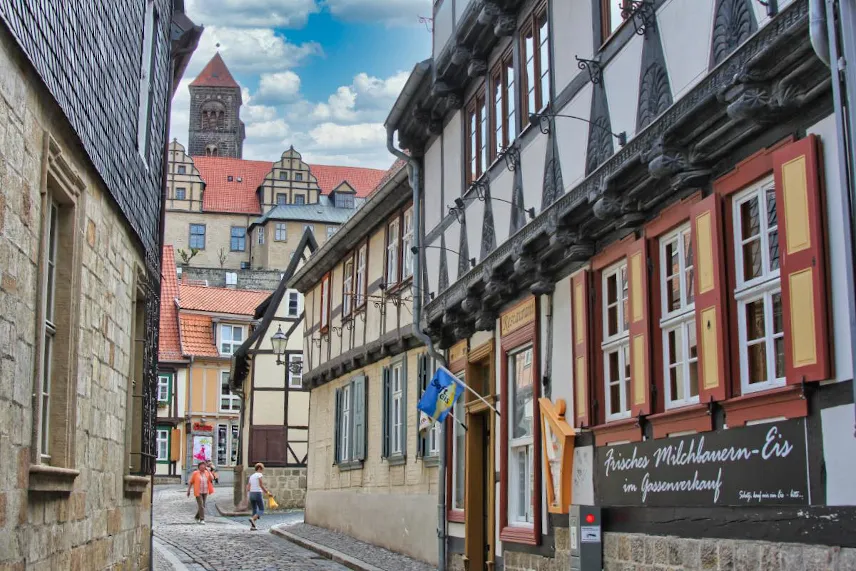
Victoria – Guide your Travel
Victoria from Guide your Travel grew up in Germany. She loves to explore the world but 2020 brought her back to Germany - namely to Hannover.

German travel bloggers share 16 hidden gems in Germany. From the north to the south and from the west to the east – whether you look for German mountains, islands, hikes, or cities.
If you google “hidden gems in Germany” you’ll find a plethora of redundant blog posts which showcase places that are not even secret spots.
So can our first travel Germany blog collab still be relevant two years after first publishing it? We think yes. While socially distanced travel is not in focus anymore, it’s still nice to get recommendations from real locals for off the beaten path Germany.
We asked German travel bloggers to share their favourite Germany experiences. We were able to compile the best places in Germany to travel from every "Bundesland" or federal state – from the mountains of the south to the islands of the north and from the towns of the east to the rolling hills of the west.
Without further ado: Here are the 16 best places to visit in Germany for your Germany bucket list. Whether you want to go on a Germany road trip or experience cool things in Germany with public transport – this blog post has got you covered.

Victoria from Guide your Travel grew up in Germany. She loves to explore the world but 2020 brought her back to Germany - namely to Hannover.
A 45-minute drive from the city centre of Hannover lies the little town Brokeloh. This is the starting point of one of the prettiest hiking paths in the area. The hike is called “Herman Löns Wanderweg” and was named after a German journalist and writer who lived in the area in the late 19th century. He is said to have hiked here for inspiration and based some of his most famous works on this beautiful area. The whole hike takes around 2.5 hours and is best done in spring, summer, or early autumn. You’ll get to see the beauty of northern Germany with its green fields, lush forests, and little hidden spots of interest. Walk through historic little villages and appreciate the serenity of this incredible place. Along the way, you’ll pass blueberry farms, historic farmhouses, and even some hills which is quite unusual for this part of Germany. This is by no means a touristy place and can even be considered a hidden secret among locals. There is no better way to spend an afternoon outdoors.


I am Nicole and I've started my travel blog newplace.newstory in 2018. I was born in Hamburg and I am still exploring the city and the surroundings of this big and beautiful metropolis.
In the first half of the 20th century, the area of the Gängeviertel reached from the Harbour of Hamburg into the old quarter where the working-class had its home. Because of bad hygienic conditions within the Cholera pandemic, the city of Hamburg decided to demolish all the houses and make room for new buildings. The starting date for the demolition was in the summer of 2009. The Gängeviertel nowadays is an art and social project with the goal to protect the rest of these old houses from further demolition. Creative people that are active in arts, politics, and social activities give the quarter its own personal charm with a mix of life, work, and culture. In the middle of downtown, you can find a piece of old Hamburg with incredible photogenic street art, graffiti, and other crazy stuff. You also find a cinema, museum, and an exhibition there.
All along the Bäckerbreitergang, between Caffamacherreihe, Valentinskamp, and Speckstraße you can still find the rest of the old houses. The Gängeviertel is easy to reach by foot from the train stations Gänsemarkt or Messehallen.
It is a room free for everybody and it's definitely worth it to visit- don't forget your camera!


I am Nina, born in Schleswig-Holstein and I write about my homeland. On my blog, you get the best tips for our northernmost state.
My beautiful Schleswig-Holstein is surrounded by the sea. East you find the baltic sea, north the northern sea. Everywhere are beaches, large ones, stony ones, and most beautiful ones. There are many islands, too. But my very favorite island, the most wonderful place is Helgoland.
The island is not big at all, it measures about 1 km and yet this beautiful piece of nature offers so much. There are the different areas of Helgoland, the Unterland, which knows how to inspire with beautiful stretches of beach. The Mittelland, which is located in the southwest and, my personal highlight, the Oberland.
A hiking trail leads along the edge of the cliff. It goes to the famous long Anna rock, past strong-climbing sheep, to the gannet and guillemot colonies. The birds breed without fear right on the side of the path and exude a fascination that is second to none. For hours I could watch them hatch the egg, how the little guillemots take off their first daring flight. Daring because they just throw themselves out of the nest without being able to fly and hope that they will learn how to do this on the 40 m fall. The Helgoland experience is rounded off by the endless expanse, the silence that comes when the day-trippers have left, the sound of the sea, the wind that blows around your nose. But in order to be able to fully empathize, you have to travel there yourself.
And that's why I invite holidaymakers and locals virtually to discover Schleswig-Holstein with open eyes, even off the beaten track and yet no less beautiful.


I'm Lara from Bremen and I started my travelblog „1000KM Reisen“ in 2020. The blog is about to travel in Germany and around (up to 1000 km distance).
My favourite outdoor spot in Bremen is the Bürgerpark. It's the most popular park and one of the biggest ones in Bremen. There are more than 200 hectares full of trees, meadows, and lakes – and that in the middle of Bremen! But there are many free-time activities in the Bürgerpark, too. In the park, you can play mini-golf, rent a boat and drive on the lakes, drink a cup of coffee at the „emma am see“ or stroke the donkeys at the little zoo. The biggest attractions in the animal area are the bentheimer pigs when they give birth. It is so funny to look at pink rookies with their black spots.
The Bremer Bürgerpark is easy to reach because it's only a few minutes from the central station. The Buslines 26 and 27 and also the tram 5 stops directly at the park. And the best of it: It's always open for everyone!


We are Alex and Svenja, a couple from Stuttgart. On April 1st we will be on slow travel for two years!
The Wutach Gorge has been with me since I was a child. There was no summer vacation without a hike along the gorge, the pleasure was usually crowned by an overnight stay in a tent, a bath in the river, or French Fries at the food stand at the Wutachmühle.
The air is particularly good, hot days are refreshing, and the botanical highlights tempting in the gorge. It was time to show my boyfriend Alex (born in Kazakhstan) this natural idyll. So we hiked all the way from Titisee-Neustadt to Lake Constance on the European long-distance hiking trail (E1).
The E1 leads from the North Cape to southern Italy and 2,000 km in Germany. The trail includes the whole Wutach Gorge. It's also crossing the highest mountain in "Baden-Württemberg" - the Feldberg.
Hiking along the Wutach Gorge is one of the highlights in southwest Germany. Anyone interested in geology and botany will be satisfied! In a few days, you walk along warm southern slopes with species-rich mixed deciduous forests. The gorge changes every year, due to erosion and offers a habitat for alpine species. The shady northern slopes of the gorge convince with fresh air and coniferous forests. Huge fir trees can be found here, but also rare orchids such as the yellow lady's slipper.


We are Tereza and Felix, a married couple with big dreams and who loves to travel, Australia and road trips. The Weltwald is our favorite place for long walks with our dog Buddy and where we clear our head and look for inspirations.
This beautiful forest is getting more popular every year and is worth a visit, especially if you love nature and you are looking for a place with fewer tourists. The forest spreads over 100 hectares, so there is a guarantee that other visitors won’t disturb you and you can admire these high trees and the blue sky.
This nature reserve offers a magnificent collection of trees from all over the Northern Hemisphere, which is really impressive. The entire nature reserve splits into 3 original trails: North America, Europe, and Asia, so you can easily go on an expedition around the world. These trails connect with each other.
You will find Maple Trees, Oak Trees, Tulip Trees, Cedars, Japanese trees, and much more. On every trail, you can read about these different trees or the areas where they come from. All the trails offer some highlights, as the Europe Garden, Botanikum, or Asia Garden.
The nature reserve is ideal for anyone who enjoys nature. While your kids can play in an Indian Village, you can enjoy a pleasant picnic.
There is no restaurant or restroom, so make sure you will not leave any footprints in the forest and take your garbage back with you.
It is located 3km north-west of Freising. The easiest way to get there is by car.
Enjoy the time in the nature reserve and admire all the surrounding beauty.


Hi, I'm Jessika and not a classic travel blogger. I love traveling but I also love blogging about various issues. One of my biggest passions is exploring my own home base: Thuringia, the green heart of Germany.
Thuringia is known for three things: Goethe, Bratwurst, and huge forests. The most popular one is the Thuringian Forest – a wonderful place for long hikes and exploring beautiful nature. There are a lot of interesting spots to visit in the Thuringian Forest, but if I had to recommend only one it would be the Metilstein opposite the UNSECO World Heritage Wartburg Castle. The Metilstein is a small mountain (more a kind of hill) above the city of Eisenach which not only convinces with its stunning view but also with its surreal landscape. Rough rocks, colourful heather, and picturesque oaks build a breath-taking composition. Especially on warm summer evenings when the sun goes down and everything is illuminated by the soft light this place looks like a fairytale location. To get the best Thuringian Forest experience you have to combine your Metilstein visit with a nice hike of course. There are a lot of options in the south of my hometown Eisenach, for example, the Drachenschlucht, the Landgrafenschlucht, and a walk around Wartburg castle.


We are Jenny and Markus from Saxony. We like to spend our free-time in nature. You can find hiking-guides for Germany and Europe on our blog.
Only 40 kilometers (25 miles) east of Dresden lies the Sächsische Schweiz - or Saxon Switzerland - a national park with an area of roughly 94 square kilometers (36 square miles). You'll rarely get as close to nature as here. The bizarre rock formations and cool canyons are some of the most beautiful hiking areas in Europe. It's the right place for people who love hiking as much as we do!
One of the most famous destinations is the Basteibrücke (or Bastei Bridge). It's 76 meters (250 feet) long and should be combined with a visit to the Schwedenlöcher (Sweden holes) canyon. More than 700 steps lead through unique rock faces. A spectacular experience for all nature lovers! In the main season, around 2000 people cross this path every day!
But there's much more to the Sächsische Schweiz! The heavily rugged rock groups of the "Schrammsteine", the 11 meters (36 feet) high rock gate “Kuhstall” or the natural wonder “Hercules Columns” are just a few of our favorite places in the Elbe Sandstone Mountains. If you're a romantic, you shouldn't miss the sunset on the Gohrisch.
By the way, Bad Schandau is the perfect starting point for all your trips. If you'd like to spend multiple days in nature you can hike the 115 kilometers (71 miles) long Malerweg in eight-day stages. The hiking trail runs through the entire Elbe Sandstone Mountains.


I'm Lisa and I started my travel blog Travellerin in August 2019 when I went on a world trip. Back in Germany, I want to show the beauties and everyday adventures right on our doorstep and encourage women to travel alone. Born and raised on Rügen, I consider myself an expert on traveling on the island.
Do you know which island is the largest in Germany? With a 926 km² area, it is Rügen - far up in the north of Germany, in the Baltic Sea. One of the most beautiful regions on Rügen is the „Halbinsel Mönchgut". On the eastern tip of the island, the clocks beat even slower. Wide, natural beaches invite you to swim, and the flat, wide land to extensive bicycle tours.
A great base for your Rügen vacation is „Göhren". Due to its location at the easternmost point of Rügen, the „Kap Nordperd", Göhren has two wonderful beaches. Göhren can be easily explored on foot within half a day - and this is best done after a stormy day. Because then, with a little luck, you will find the „gold of the Baltic Sea": amber - a yellow gemstone made of fossil resin.
If you have seen everything of Göhren, then it's time to discover the „Halbinsel Mönchgut" by bike. Mönchgut is a bit „the original Rügen": Deeply cut bays, cliffs, sandy beaches, wide fields, and fragrant coniferous trees right by the sea. Everywhere still resonates the charm of the traditional time of the „Mönchguter" fishermen.
My tip: Cycle from Göhren via Lobbe to Thiessow and Klein Zicker. Pass bright poppy and rapeseed fields as well as romantic-looking thatched roofs. Stopovers that are worthwhile: The small harbor in Gager (here you can sleep in a houseboat!), the village of Thiessow, the fishermen's smokehouse Dumrath near Groß Zicker, and of course the long beach path on the east side.

We are Philipp and Carina, who started our travel blog bucketlist2life in December 2020. We moved to Berlin in 2008 and have explored a lot since.
The Teufelsberg or Devil's Mountain is one of the many debris hills in Berlin. It is a man-made hill out of debris from World War II and with 120m (394 ft) above sea level the second highest elevation in Berlin. You have a great view over the Grunewald forest and western Berlin with the Funkturm (the West Berlin TV Tower). As the area belonged to West Berlin during the Cold War, there is an old U.S. listening station on the hill.
The hill is easy to reach by foot from the train stations Grunewald or Heerstraße via a walk through the beautiful Grunewald, which also boasts lakes and sand dunes to relax in summer and hence makes for a great day trip in itself. The steep road up the hill is used by mountain bikers and skateboarders in summer as well as tobogganers and snowboarders in winter. You can enter the area of the old listening station for a small fee. Here, you can have cool drinks, listen to some music, admire the incredible street art all around and soak in the views.


Frank's home is Brandenburg. On his blog, which has a strong focus on castles, he mostly writes about excursions in his area.
In the middle of the natural preserve “Hoher Fläming” is located the village Wiesenburg. If you take one of the many hiking trails, such as the certified art trail, you will see the church and castle tower from afar, which tell you about this historic gem. A walk through the village reveals the full beauty of its historic center. Lovingly restored half-timbered houses line up and lead directly to its center: the castle. But the jewel is undoubtedly the castle park. The park is the most important work of landscape art between Potsdam's Sanssouci Park and the Dessau-Wörlitz Garden Kingdom. The parterre, elaborately designed in the 19th century, with its curved carpets of flowers below the palace, is a real eye-catcher - unique in eastern Germany. Behind it stretches a large landscape park that merges into an enchanted forest park. Several visual axes in the park provide repeated views of the castle, church, and forester's lodge. A lovely place for walks and excursions.


Peter is from the East of Germany and has now moved even further East to Ukraine and runs a tour business and a blog. He still loves to visit and write about his home region and tells all foreigners to visit someday.
The Harz is one of the most beautiful regions in Germany and despite its many German visitors, foreigners are still a rare sight here. That's a pity because in beautiful medieval towns like Quedlinburg you can't just see how the middle ages looked like, you can actually experience it on tours and by visiting one of the many half-timbered houses. One can only wonder why the UNESCO sites here don't get as much attention as similar ones in the West of Germany. From Quedlinburg, you can also take a trip with the narrow gauge railways of the Harzer Schmalspurbahnen. There are different routes. Quedlinburg is at the end of the Selketalbahn which crosses a picturesque river valley. With one change it's also possible to visit the mountain Brocken, which is the highest mountain in the Northern part of Germany and from which you have a fantastic view of up to 100 kilometers. After your day trip, you can try local beers and other specialities in the many restaurants and cafes of Quedlinburg. One cafe is even in a block of seven buildings. You just gotta love the Harz!


I am Martina and my travel blog HundeReisenMehr is all about traveling with my two dogs. Apart from hiking in the Westerwald, I love traveling through Germany and exploring neighboring European countries.
For almost 7 years the Westerwald in Rhineland-Palatinate has been my home. And for almost 7 years I have been surprised that this wonderful region is still quite underestimated as a vacation and hiking region and is still little known. Yet the Westerwald is not only conveniently located between the Rhine-Main area and the Cologne/Bonn metropolitan region, but also has a lot to offer.
Of course, the Westerwald stands especially for hiking – whether alone, in a group with children, or with a dog. There are many great hiking trails – from the Westerwaldsteig (which is also suitable for not-so-experienced hikers) to themed trails that inform about the myths and mineral resources of the region, to relaxing walks around the Westerwald lake district.
A vacation in the Westerwald is also interesting for families. For example, young and old tourists can visit Stöffel Park and learn about the history of the "Stöffel mouse", which drowned in a lava lake about 25 million years ago, and experience first-hand how basalt was quarried in earlier times. If you come to the Westerwald in summer, you can spend a wonderful day on the water at the "Wiesensee" near Westerburg – with lazing around and lots of beach feeling. And if you've had enough of nature, you can visit such charming little towns as Bad Marienberg, Hachenburg, and Montabaur, or take a trip to Koblenz and Bad Ems.


reiseblog.saarland started in 2015 as part of the Tourismus Zentrale Saarland. The Author Sabine Caspar promotes tourism in Saarland since 1999.
My highlight in nature actually is the "Urban Jungle", located right on the doorstep of Saarbrücken, the capital of Saarland. The forest, which has been left in its natural state for more than 20 years, invites visitors on a “jungle tour”, where fallen trees, eroded paths, colourful fungi, flowers, and bizarre-looking lichens create a great contrast to civilisation. The "Urban Jungle" provides fun and adventure for young and old alike.
Saarland's history, which is as varied as its nature, is characterized by the changes of its nationality: Sometimes German, sometimes French. Once, it even was an independent state. Numerous relicts, such as winding towers and mines from the most recent past, the mining era, are still preserved. Some of them have already grown together with nature. Others can be experienced as museums with spectacular stagings. A monument as a symbol of memory and change is one of my favorite places. I'm talking about the Saarpolygon, a large sculpture made of steel. It looks different depending on where you stand, even from far away it's visible and shows itself in a new shape. From its top, I have a magnificent view over large parts of the Saarland. On a clear day, the view extends all the way to France.


We are Tanja & Ramon and live on the brim of southern Hesse, in the municipality of Biebesheim am Rhein. We are not city people, we love the beauty of nature. In Biebesheim we have a special natural highlight every year.
The storks are coming!
Biebesheim am Rhein is also called the “secret stork capital of Germany”. Every year in March white storks (the ones who bring the babies ;-) ) come to us in Biebesheim. You could also say that the storks are coming home. They build their nests and breed from March to June. The bird park in Biebesheim is a great place for stork watching. The nests can be found either in the trees or on higher platforms that the community has set up for the storks. It is nice to watch the storks, be it breeding, approaching their nest, in-flight to the feeding grounds, in the meadows looking for food, or when they are circling high in the sky above you. And don't forget their rattle! It cannot be ignored. They communicate by clattering their beak. They use it to greet the partner in the nest or as a defense against nest competitors. Without the rattling, something would be missing in Biebesheim!
Did you know that they are also one of the most important employees of the fields in Biebesheim? Since the storks feed on small animals such as earthworms, insects, rats, mice ... they help our farmers to regulate the mouse population. That is why you can often see them in large numbers in our fields. In October, after rearing the young and working hard in the fields, the storks move south again. Have a nice flight, see you next year!


We are Juliana and Jonas and come from the Sauerland. We are very fond of traveling and always want to go far away, but this spot makes us realize again and again how nice it is at home.
In Sauerland, there are a lot of beautiful spots. One of the nicest is not far from where we live.
Between the village Grafschaft and Gleidorf, there is the Wilzenberg, which is 658 meters high and offers great views.
You have the possibility to park at the hiking parking lot Wilzenberg, from there it is only a short 1.5km hike to the famous Wilzenberg tower.
You can walk either crosswise and steeply up and down through the forest, or you can take the easier way, which is partly tarred. Halfway you can take a break, there are benches and also a chapel. You will also find some information boards.
If you continue walking, you will come to the Wilzenberg tower, which is 17 meters high. On the tower, there are metal plaques with names of places to know where to see which village or town.
It is a beautiful spot for sunrise and sunset to enjoy the whole panorama.
